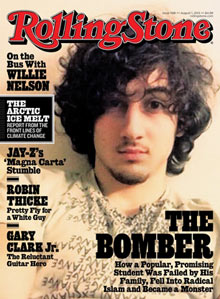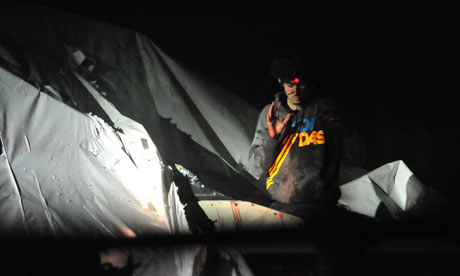Boston police photographer Sean Murphy is relieved of duties after releasing images as expression of anger at Rolling Stone's controversial cover


Murphy said he was insulted by Rolling Stone's Tsarnaev cover: 'There is nothing glamorous in bringing more pain to a grieving family. Credit: Boston magazine
According to the photographer who took the haunting picture, this is the real face of terrorism, not the "glamourised" image of the surviving suspect of the Boston marathon bombings, Dzhokhar Tsarnaev, that appears on the cover of next month's Rolling Stone magazine. The photograph was taken by Sergeant Sean Murphy, a tactical photographer with the Massachusetts state police, who accompanied Swat teams as they apprehended Tsarnaev in Watertown in April following one of the largest manhunts in US history.
Murphy released a sequence of his official pictures to Boston magazine as an expression of his anger towards Rolling Stone's depiction of the bombing suspect. The release was unauthorised and Murphy was relieved of his duties on Thursday night, pending an investigation.
The move adds to the billowing controversy surrounding Rolling Stone's choice of cover image that has Tsarnaev staring straight out at the reader, his dark curls framing his face above the headline 'The Bomber'.
The use of Tsarnaev's portrait in a cover design more frequently used to tease profiles of rock stars has provoked a storm of protest from those like Thomas Menino, the mayor of Boston, who said the magazine was rewarding "a terrorist with celebrity treatment". Murphy's criticism further fuels the dispute.
Murphy told Boston magazine that as a law-enforcement officer for 25 years, he was insulted by the Rolling Stones image. "The truth is that glamorizing the face of terror is not just insulting to the family members of those killed in the line of duty, [but] it also could be an incentive to those who may be unstable to do something to get their face on the cover of Rolling Stone magazine."
In a sequence of dramatic pictures taken on 19 April, Murphy captures Tsarnaev in the act of emerging from the boat in which he hid for hours surrounded by heavily armed special FBI forces. One picture shows him stepping out of the yacht, his belly exposed, his head covered in blood. Another has him slumped over the side of the boat, his head resting on his right arm, the other arm falling limp by his side.
A fourth image shows Tsarnaev lying on the ground receiving emergency medical assistance. The images contrast strikingly with the serenely attractive portrait chosen by Rolling Stone. Massachusetts state police said Murphy had released the photographs without permission, and that he had been placed under investigation.
Murphy complained that the Rolling Stone cover had put many of the Boston marathon victims back into trauma. It has "kept many of them up – again. It's irritated the wounds that will never heal – again. There is nothing glamorous in bringing more pain to a grieving family."
He continued: "Photography is very simple; it's very basic. It brings us back to the cave. An image like this on the cover of Rolling Stone … we see it instantly as being wrong. What Rolling Stone did was wrong. This guy is evil. This is the real Boston bomber. Not someone fluffed and buffed for the cover of Rolling Stone magazine."
The Rolling Stone cover flagged up a long profile of the younger Tsarnaev by Janet Reitman. In an editorial note added to the piece by the magazine's editors, they write that "the fact that Dzhokhar Tsarnaev is young, and in the same age group as many of our readers, makes it all the more imortant for us to examine the complexities of this issue and gain a more complete understanding of how a tragedy like this happens."
Tsarnaev has pleaded not guilty to 30 federal charges arising from the Boston bombings. He is accused of killing four people, detonating a weapon of mass destruction and malicious destruction of property, with 17 of the 30 charges carrying the death penalty.
John Wolfson, the editor of Boston magazine, told CNN that the option to publish Murphy's photographs had happened quickly. "This is a measure of how deeply he feels, I think he felt conflicted on some level about releasing these photos, but I also think he felt like this was something he frankly had to do."





Post a Comment